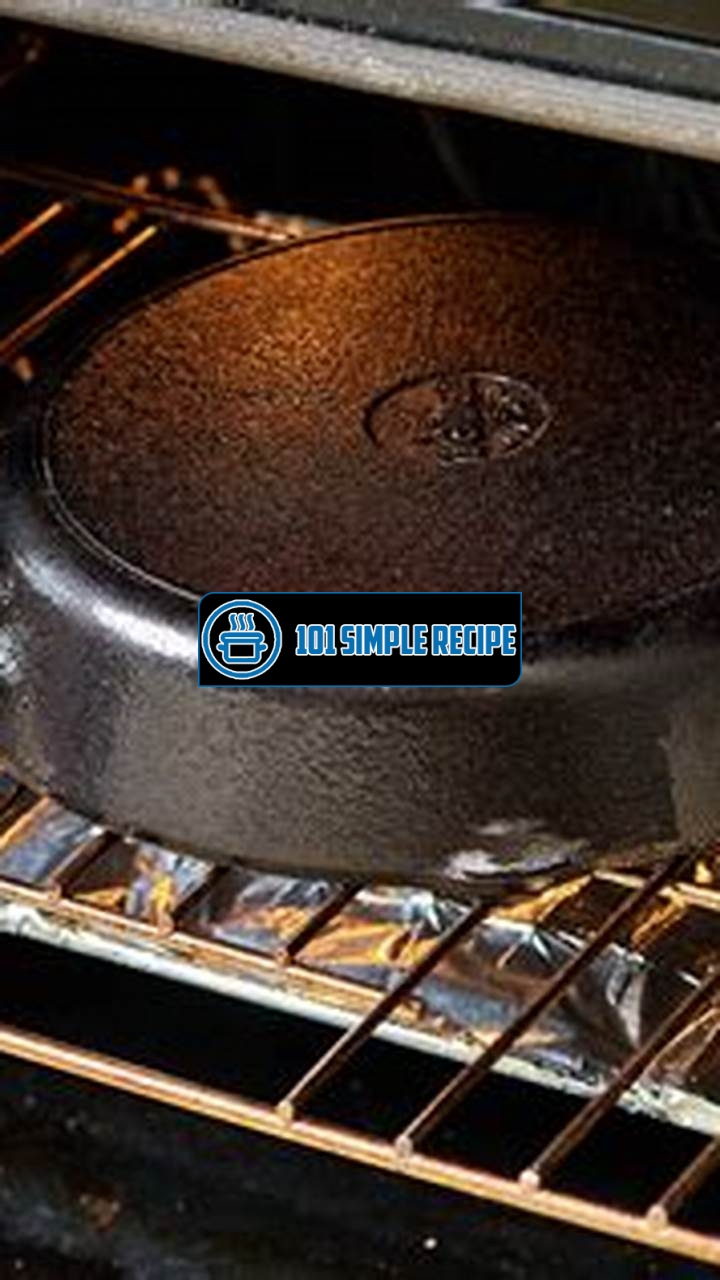Discover the secret to perfectly seasoned cast iron and elevate your cooking game to a whole new level! Cast iron cookware has been a staple in kitchens for centuries, known for its durability and ability to retain heat. But there’s more to it than meets the eye – the real magic lies in the seasoning. Whether you’re a seasoned home chef or just starting out, understanding the science behind the perfect seasoning can make all the difference in your kitchen adventures. So, get ready to unlock the mysteries of cast iron seasoning and embrace a whole new world of culinary possibilities!

Preparing Your Cast Iron
Before you can start baking with your cast iron and seasoning it properly, there are a few important steps you need to take. These steps will ensure that your cast iron is clean, rust-free, and ready to use.
Cleaning Your Cast Iron
The first step in preparing your cast iron is to clean it thoroughly. This is important to remove any dirt, grime, or food residue that may be on the surface. Start by rinsing the cast iron pan with hot water to loosen any stuck-on bits. Use a soft brush or sponge to scrub the surface gently. Avoid using harsh cleaners or abrasive scrubbers as they can damage the seasoning.
Important point: Clean your cast iron with hot water and a gentle brush or sponge to remove any dirt or food residue. Avoid using harsh cleaners or abrasive scrubbers.
Once you have cleaned the pan, you can use a mild dish soap to give it a thorough wash. Make sure to rinse it well to remove all soap residue. After washing, dry the cast iron pan using a clean towel or by placing it on the stovetop over low heat. This will help to evaporate any remaining moisture and prevent rust from forming.
Important point: Dry your cast iron thoroughly after washing to prevent rust from forming.
Removing Rust from Your Cast Iron
If your cast iron has developed rust spots, it is important to remove them before seasoning. Rust can affect the flavor of your food and make the pan more difficult to clean. To remove rust, start by scrubbing the affected area with steel wool or a stiff brush. Apply a thin layer of vegetable oil to the rusty spots and allow it to sit for a few hours. Then, scrub the area again to remove the rust. Repeat this process if necessary until all rust spots are gone.
Important point: Remove rust from your cast iron by scrubbing with steel wool and applying a thin layer of vegetable oil.
Drying Your Cast Iron
After cleaning and removing rust from your cast iron, it is crucial to dry it thoroughly before seasoning. Any remaining moisture can lead to rust formation and affect the quality of your seasoning. To dry your cast iron, place it on the stovetop over low heat or in a warm oven for a few minutes. Alternatively, you can dry it by wiping it with a clean towel and allowing it to air dry completely. Make sure to store your cast iron in a dry place to prevent any moisture from accumulating.
Important point: Dry your cast iron completely before seasoning to prevent rust and maintain the quality of your seasoning.
By following these important steps, you will have a perfectly prepared cast iron pan ready for baking and seasoning. Cleaning, removing rust, and drying your cast iron are crucial to ensure its longevity and maintain a non-stick surface. Take the time to properly prepare your cast iron, and you will enjoy the benefits of cooking with this versatile and durable cookware.
Choosing the Right Oil
When it comes to seasoning your cast iron, choosing the right oil is crucial. The oil you use not only affects the overall flavor of your food, but also plays a key role in building up a non-stick surface on your cast iron pan. With so many options available, it’s important to know which oils are best suited for this purpose and why they are effective.
Types of Oils for Seasoning
There are several types of oils that are commonly used for seasoning cast iron. Some popular choices include:
- Vegetable Oil: Vegetable oil is a versatile option that works well for seasoning cast iron. It has a high smoking point, allowing it to withstand the high heat needed for the seasoning process.
- Flaxseed Oil: Flaxseed oil is known for its ability to create a durable and long-lasting seasoning on cast iron. It polymerizes when heated, creating a hard and slick surface.
- Grapeseed Oil: Grapeseed oil is another oil with a high smoking point, making it suitable for seasoning cast iron. It also has a neutral flavor, allowing the natural taste of your food to shine through.
- Canola Oil: Canola oil is often preferred for its affordability and widespread availability. It is a good all-purpose oil that can be used for both cooking and seasoning.
Benefits of Different Oils
Each type of oil used for seasoning cast iron has its own unique benefits:
- Vegetable oil is a popular choice due to its versatility and high smoking point. It creates a reliable non-stick coating on the cast iron surface, making cooking and cleaning easier.
- Flaxseed oil is highly praised for its ability to develop a strong and durable seasoning. It forms a natural layer that protects the cast iron from rust and provides excellent non-stick properties.
- Grapeseed oil not only withstands high heat, but also enhances the natural flavors of your food. It is a lighter oil that won’t leave a heavy residue on your cast iron.
- Canola oil is a cost-effective option that still provides a good seasoning. It is readily available and can be used for a variety of cooking purposes.
Common Mistakes to Avoid with Oil Choice
While choosing the right oil is important, there are also some common mistakes to avoid:
- Avoid using oils with low smoking points, such as olive oil or butter, as they may burn during the seasoning process.
- Don’t use oils that have gone rancid, as they can leave an unpleasant taste on your seasoned cast iron.
- Be cautious when using flavored oils, as they may leave a residue or alter the taste of your food.
- Avoid using oils with additives or high levels of saturated fats, as they can hinder the seasoning process.
By selecting the right oil for seasoning your cast iron and avoiding these common mistakes, you’ll be on your way to perfectly seasoned cookware that will enhance your culinary creations for years to come.
Seasoning Your Cast Iron
When it comes to cooking with cast iron, the key to success lies in properly seasoning your skillet or pan. Seasoning your cast iron not only creates a non-stick surface but also enhances its durability, ensuring that it will last for generations to come. In this guide, we will walk you through the step-by-step process of seasoning your cast iron, so you can enjoy the benefits of cooking with this versatile cookware.
Coating Your Cast Iron with Oil
The first step in seasoning your cast iron is to coat it with a layer of oil. This helps to create that desirable non-stick surface. Start by thoroughly cleaning your cast iron with hot water and a mild detergent. Use a stiff brush to remove any food residue or built-up grease. Rinse the skillet or pan with water and pat it dry with a clean towel.
Now it’s time to apply the oil. Choose an oil with a high smoke point, such as vegetable oil or flaxseed oil. Pour a small amount of oil onto a paper towel or cloth and rub it all over the surface of the cast iron, inside and out. Be sure to coat the handles as well. The goal is to create a thin, even layer of oil on the cast iron’s surface.
Note: You can also use lard or shortening instead of oil, if you prefer. These fats can add flavor to your cast iron, giving your dishes a unique taste.
Baking Your Cast Iron
Once your cast iron is coated with oil, it’s time to bake it. Preheat your oven to 350°F (175°C). Place your cast iron upside down on the top rack of the oven, with a baking sheet or aluminum foil on the bottom rack to catch any drips. This prevents your oven from becoming a smoky mess.
Leave your cast iron in the oven for one hour. This allows the oil to penetrate into the pores of the cast iron, creating a hard, durable seasoning layer. The heat also helps to break down any remaining oil, creating a smooth, non-stick surface. Remember to use oven mitts or potholders when handling the hot cast iron.
Repeating the Seasoning Process
After the first seasoning round, you may wonder if you need to repeat the process. The answer depends on the condition of your cast iron. If it appears to have a good seasoning layer, you can start using it right away. However, if the surface still feels sticky or shows signs of rust, it’s best to repeat the seasoning process.
Complete the coating and baking steps outlined above, ensuring that you apply a thin layer of oil and bake your cast iron for one hour. You can repeat this process as many times as necessary until you achieve the desired results. The more you season your cast iron, the better the non-stick surface will become.
Note: It’s important to avoid using soap when cleaning your cast iron after each use. This can strip away the seasoning layer you worked so hard to create. Instead, use hot water and a gentle scrub brush to clean your cast iron. Dry it thoroughly and apply a thin layer of oil before storing to maintain its seasoning.
By following these steps and being patient, you can achieve a perfectly seasoned cast iron skillet or pan. The non-stick surface and enhanced durability will make your cooking experience a breeze. So don’t wait any longer – start seasoning your cast iron today and discover the secret to perfectly seasoned cooking!
Using Your Seasoned Cast Iron
When it comes to cooking, using a properly seasoned cast iron can take your dishes to a whole new level. The secret to perfectly seasoned cast iron lies in the process of baking it. By baking your cast iron, you create a layer of seasoning that not only enhances the flavor of your food but also protects the pan from rust and provides a smooth cooking surface.
Now that you have your perfectly seasoned cast iron, let’s dive into how you can make the most of it:
Cooking Tips for Seasoned Cast Iron
1. Preheat your cast iron: Before you start cooking, preheat your cast iron on low to medium heat. This ensures even heat distribution and prevents food from sticking to the surface.
2. Use oil or fat: Adding a small amount of oil or fat to your cast iron before cooking can further enhance its non-stick properties. You can use cooking oils such as vegetable oil, canola oil, or even animal fats like bacon grease.
3. Avoid acidic foods: While cast iron is great for most types of cooking, it’s best to avoid cooking acidic foods such as tomatoes or citrus fruits. The acidity can break down the seasoning and affect the flavor of your dish.
4. Don’t overcrowd the pan: Give your food enough space to cook evenly by avoiding overcrowding the pan. This allows for proper heat circulation and ensures that your dishes turn out perfectly cooked.
5. Monitor your heat: Cast iron retains heat well, so be mindful of the temperature while cooking. Adjust the heat accordingly to prevent your food from burning or sticking. ♨️
Cleaning Your Seasoned Cast Iron
To maintain the seasoning of your cast iron, it’s essential to clean it properly after each use:
1. Wait for it to cool: Allow your cast iron to cool down completely before cleaning. Cleaning it while it’s hot can damage the seasoning and make your pan more susceptible to rust.
2. Use hot water and a brush: Rinse your cast iron with hot water and use a brush or sponge to scrub off any food residue. Avoid using harsh soaps or metal scrubbers as they can strip away the seasoning.
3. Dry it thoroughly: After cleaning, make sure to dry your cast iron completely to prevent moisture from causing rust. You can towel dry it or place it on low heat for a few minutes to evaporate any remaining water.
Storing Your Seasoned Cast Iron (extra details)
Properly storing your seasoned cast iron can help maintain its seasoning and prolong its lifespan:
1. Coat with oil: Apply a thin layer of oil to your cast iron before storing it. This helps prevent rust and keeps the seasoning intact.
2. Store in a dry place: Find a cool, dry place to store your cast iron to avoid any moisture buildup. If possible, place a paper towel or cloth inside the pan to absorb any excess moisture. ️
3. Avoid stacking: Stacking your cast iron pans can lead to scratches and damage the seasoning. If you have multiple pieces, consider using pan protectors or storing them separately.
By following these tips for cooking, cleaning, and storing your seasoned cast iron, you can enjoy the benefits of this versatile cookware for years to come. Whether you’re frying, baking, or sautéing, your perfectly seasoned cast iron will always deliver delicious results. Happy cooking!
Restoring Neglected Cast Iron
Is your cast iron cookware looking neglected and rusty? Don’t worry, you can easily bring it back to its former glory with a little bit of effort and the right techniques. Here, we will guide you through the process of restoring neglected cast iron, from removing rust to re-seasoning it for better cooking performance. By following these steps, you can ensure that your cast iron cookware remains in top condition for many years to come.
Removing Rust from Neglected Cast Iron
Before you can re-season your neglected cast iron, it is crucial to remove any rust that has formed on the surface. Rust not only affects the appearance of your cookware but can also impact its cooking performance. To remove rust, you can start by scrubbing the affected area with a mixture of coarse salt and vegetable oil. This abrasive mixture will help to loosen and lift the rust particles. Use a scrub brush or a sponge to gently scrub the surface, paying extra attention to the rusted spots. Rinse the cookware thoroughly and dry it completely.
Important point: When removing rust from neglected cast iron, make sure to avoid using harsh chemicals or abrasive materials such as steel wool, as these can damage the seasoning and the surface of your cookware.
Re-Seasoning Neglected Cast Iron
Once you have successfully removed the rust from your cast iron, it is time to re-season it. Seasoning your cast iron creates a protective layer that prevents rust and provides a non-stick surface for cooking. To re-season your neglected cast iron, start by preheating your oven to 350°F (175°C). While the oven is heating, apply a thin layer of vegetable oil or melted shortening to the entire surface of the cookware, including the handles. Place the cookware upside down in the oven to catch any excess oil. Bake for about an hour, then turn off the oven and let the cookware cool down completely. The heat will help the oil to polymerize and form a durable seasoning.
Important point: It is essential to wipe off any excess oil from the surface of your cast iron before placing it in the oven, as too much oil can result in a sticky finish.
Preventing Future Neglect
Now that you have successfully restored your neglected cast iron, it’s important to take steps to prevent future neglect. One of the easiest ways to do this is by using and maintaining your cast iron regularly. After each use, gently clean it with a brush or sponge and hot water, avoiding soap or harsh detergents. Dry it thoroughly to prevent moisture from causing rust. Additionally, it’s advisable to apply a light coating of oil after each use to maintain the seasoning and protect the surface.
Important point: If you notice any signs of rust or the seasoning wearing off, it’s essential to address it promptly to prevent further damage. Regular maintenance and care will ensure that your cast iron remains in excellent condition for many years.
In conclusion, by following the steps outlined above, you can restore neglected cast iron and enjoy its many benefits in your cooking. Remember to remove rust, re-season, and take preventive measures for the future. With proper care, your cast iron cookware will continue to serve you well in the kitchen for generations to come.
Thank you for taking the time to read our article on baking cast iron to season. We hope you found the information helpful and informative. If you have any further questions or need more tips on cast iron seasoning, please don’t hesitate to reach out. We are here to help! Make sure to visit our website again for more articles and updates on cooking techniques and recipes. Happy cooking!
Frequently Asked Questions
Here are some common questions about baking cast iron to season:
| No. | Questions | Answers |
|---|---|---|
| 1. | How long should I bake my cast iron for seasoning? | You should bake your cast iron for about an hour to ensure a proper seasoning. |
| 2. | Can I season my cast iron with vegetable oil? | Yes, vegetable oil is a great option for seasoning your cast iron. |
| 3. | Do I need to season a new cast iron pan? | Yes, it is recommended to season a new cast iron pan before using it. |
| 4. | How often should I season my cast iron? | It is recommended to season your cast iron every few months or as needed. |
| 5. | Can I use soap to clean my seasoned cast iron? | It is best to avoid using soap on your seasoned cast iron to preserve the seasoning. |
| 6. | Can I season my cast iron on a grill? | Yes, you can season your cast iron on a grill for added convenience. |
Thanks for Reading!
We appreciate you taking the time to read our article. We hope you found the information valuable and that it helps you achieve perfectly seasoned cast iron cookware. Don’t forget to visit us again for more helpful tips and tricks in the kitchen. Happy cooking!
Jump to Recipe
Baking Cast Iron to Season

Learn how to properly season your cast iron cookware by baking it.
- 1 cast iron pan
- vegetable oil
- Preheat your oven to 350°F (175°C).
- Apply a thin layer of vegetable oil to the entire surface of the cast iron pan, including the handle.
- Place the oiled pan upside down on the middle rack of your preheated oven. Bake for 1 hour.
- Turn off the oven and allow the pan to cool completely before removing it.
- Using a lint-free cloth or paper towel, wipe off any excess oil from the cast iron pan.
- Your cast iron pan is now seasoned and ready to use or store for future use.




